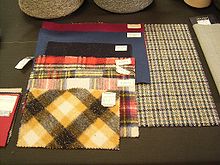Wülfing Museum
The Wülfing Museum is located on the site of the former cloth factory "Johann Wülfing & Sohn" in Radevormwald - Dahlerau in the Oberbergisches Kreis in North Rhine-Westphalia , Germany .
Company named Johann Wülfing & Sohn
The name-giving company was founded in Lennep in 1674 . Due to the Napoleonic continental dam, the owners at that time moved to the Wupper in today's district of Dahlerau at the beginning of the 19th century . This happened primarily because of the cheap water wheels to be built at this point . In the course of the industrial revolution , the production site grew continuously, the hydroelectric power plants stationed there were gradually replaced by steam engines and modern run-of-river power plants . Within the ensemble of the former cloth factory there is a building from 1838 , which was the oldest factory building in Germany until the company went bankrupt . In the immediate vicinity of the factory, the company built many company apartments , so that a small city district was created at this point. Until the end of the business in 1996 , Johann Wülfing & Sohn produced high-quality woolen cloths from worsted yarn , mixed with equally high-quality synthetic fibers . The company processed its materials from raw materials through to the finished small series of a men's suit as a sample for clothing . The reason for this success lay in the long company tradition , for example Johann Wülfing & Sohn maintained a large archive for fabric samples from which new fashion trends for the coming season could be drawn over and over again . For this purpose, a collection of around 1000 patterns was put on, which were produced in the in-house pattern weaving facility. The fabric samples were used to make men's suits of various sizes. The company's customers examined the garments produced and then selected around 200 samples, which were then mass-produced. The suits that were no longer required were sold ex works to interested end customers.
The last owner of the company was the Radevormwalder honorary citizen Fritz Hardt .
The company as an early power company
Due to the considerable fire risk in the production facilities, electrical lighting was introduced very early on in the Wülfing factories . The electricity required for this was generated with the help of the water turbines and steam engines available in the company as well as generators connected to the transmissions . The surplus of three-phase current of up to 140 kW at 5,000 volts was fed into the power grid that was under construction , which also belonged to the company until 1911 . The generator from 1903 served to cover the company's own needs until 1946 and was then shut down. It is still at its original location and, driven by an electric motor, produces the electricity for some light bulbs during demonstrations . A modernized Francis turbine from 1922 is also still available, which has an output of around 250 kW within a run-of-river power plant .
museum
The steam engine still on the factory premises was a horizontal composite machine with two cylinders . It was built in 1891 and was in use until 1961 . The machine, which has more than 300 hp , supplied the factory with mechanical energy via transmissions and the surrounding area with electrical power via the generator that was also still in existence. Because its owners did not want to part with it after its closure, it has remained at its location to this day. The museum shows the steam engine with all its equipment, machines for textile production and, as a special feature, a laboratory for quality assurance in the textile industry . The neighboring run- of - river power plant from 1922, which is still in operation, can also be visited. The museum has two 80-year-old jacquard looms with punched card controls that were used in pattern weaving because of their flexible operation.
The museum is run by former and now retired employees of Johann Wülfing & Sohn , who are continuing the old tradition in this way.
useful information
A mixed business park has set up on the other premises, including a small spinning mill for special textiles .
Dahlerau in general and the museum in particular is part of a route of the "Bergischer Ring". Historic vehicles are used to travel to historic stations all over the Bergisches Land, the route “Tuchmacher-Tour” has, among other things, the Wülfing factory as its destination.
literature
- Benjamin Obermüller: Between the special route and the industry trend. The worsted yarn spinning mill Johann Wülfing & Sohn during National Socialism (1933 to 1939) , Der Andere Verlag, Tönning u. a. 2006, ISBN 3-89959-470-3 .
- Benjamin Obermüller: Between the special route and the industry trend. The worsted yarn spinning mill Johann Wülfing & Sohn from 1933 to 1939 , in: Romerike Berge 56 (2006), pp. 17-26.
- Benjamin Obermüller: Worsted yarn fell into a deep crisis. The worsted yarn spinning mill Johann Wülfing & Sohn 1933 to 1939 , in: Geschichte und Heimat 72 (2005), 5, Bl. 1–2.
Web links
Coordinates: 51 ° 13 ′ 15 ″ N , 7 ° 18 ′ 57 ″ E





